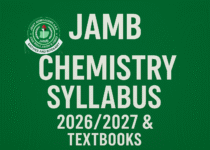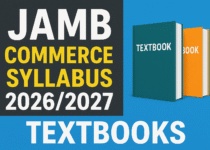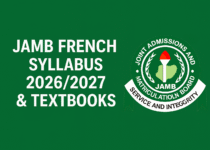JAMB Art Syllabus 2026/2027 & Textbooks
The JAMB Art syllabus 2026/2027 covers topics including the classification of arts, elements and principles of design, artistic skills and techniques, historical art periods, art appreciation, and the meaning and functions of art in society. Candidates should also be familiar with art terms, craft skills, and the development of contemporary art.
The syllabus aims to test a candidate’s knowledge of art fundamentals, historical context, and practical and theoretical skills.
Objective
The aim of the Unified Tertiary Matriculation Examination (UTME) syllabus in Art is to prepare the candidates for the Board’s examination.
(i): Candidates must exhibit knowledge of the fundamental elements, principles, and terminologies of art;
(ii) Candiates must show knowledge of historical dimensions of art with emphasis on Nigerian arts and crafts;
(iii) Candidates must demonstrate knowledge of artistic techniques, processes, the use of materials and maintenance of tools and equipment;
(iv) Candidates Must display aesthetic awareness of the environment, meaning and functions of art in society.
JAMB Art Syllabus 2026/2027
| JAMB FINE ART SYLLABUS | ||
|---|---|---|
| SN | TOPICS | OBJECTIVES |
| 1 | SECTION A | |
| CLASSIFICATION OF ART: Visual Arts: (Fine and Applied Arts) Performing Arts: (Music, Dance and Drama) Literary Arts: (Poetry, Prose, Recitals) etc. 2. ELEMENTS AND PRINCIPLES OF DESIGN: Elements: line, color, shape, form, texture, tone, value, space etc. Principles: balance, rhythm, proportion, harmony, contrast, repetition, dominance, variety, etc. 3. ART TERMS: Pigments, motif, greenware, armature, silhouette, chiaroscuro, cire perdue, terracotta etc. | Candidates should be able to: i. differentiate between the three branches of art Candidates should be able to: i. identify the elements of design; ii. analyze the principles of design; Candidates should be able to: i. identify art terms; ii. link the terms to their areas of art; iii. use the terms in analyzing artworks | |
| 2 | SECTION B | |
| 1. HISTORICAL DIMENSIONS OF ART: Prehistoric, Greek and Roman Art; Medieval Art: architecture, surface decorations and calligraphy; Renaissance Art and Artists: Giotto Di Bondone, Michelangelo Buonarroti, Leonardo da Vinci and Raphael (Raffaello Santi); 19th and 20th Century art movements; Impressionism, Realism, Futurism, Cubism, Bauhaus, Pop art, Abstract Expressionism and Fauvism. 2. TRADITIONAL AFRICAN ART: Egypt, Ashanti, Dogon, Mossi, Fon, Senufo, Bambara, Mende, Kissi, Bamileke and Bakumba. 3. TRADITIONAL NIGERIAN ART: Nok, Igbo-Ukwu, Ife, Benin, Esie, Igala, Jukun, Akwashi, and Mbari 4. NIGERIAN CRAFTS: Pottery, woodworks, cloth-weaving, carving, leather works, metal works, beadworks, body decoration, mat and cane weaving. 5. DEVELOPMENT IN CONTEMPORARY NIGERIAN ARTS AND ARTISTS: Art Schools: Zaria, Nsukka, Osogbo group etc. Nigerian artists and art educators; Aina Onabolu, Ben Enwonwu, S. I. Wangboje, Jimoh Akolo, Dele Jegede etc. Museums, galleries and art centers; Art institutions, cultural art centers, national art organizations – Nigerian Society for Education through Arts (NSEA), Society for Nigerian Artists (S.N.A), National Council for Arts and Culture (N.C.A.C), etc. Major Festivals: Argungu Fishing Festival, Eyo, Egungun, Iri-ji (New Yam), Durbar, Igue, Ekpo, Odo, etc. | Candidates should be able to: i. compare their materials, styles and techniques; ii. classify the periods and styles with emphasis on architecture, surface decoration and calligraphy; iii. compare the artists, their works and styles; iv. differentiate between the various art movements. v. analyze their styles techniques, innovations and influences Candidates should be able to: i. categorize works in terms of style, materials and locations; ii. categorize works in terms of styles, materials and locations Candidates should be able to; i. analyze the works in terms of functions, characteristics and locations Candidates should be able to: i. trace the origins, locations and styles; Candidates should be able to: i. determine the influence of the art schools and groups; ii. assess the artists in terms of their works, specializations, techniques and styles; iii. analyze the functions of museums, galleries, art centers and art institutions; iv. evaluate their impact on the development of art; v. assess their roles and functions; vi. examine the impact of major festivals on art and culture. | |
| 3 | SECTION C | |
| 1. ARTISTIC SKILLS, TECHNIQUES AND PROCESSES Two-Dimensional Art: drawing, painting, graphics and textile design. Perspective: i. Linear, angular, aerial, parallel etc. ii. Perspective terms: foreground, picture plane, eye-level, vanishing point, foreshortening, optical illusion, depth etc. Sculpture, Ceramics and Crafts, Computer Graphics: CorelDraw 2. TOOLS, MATERIALS AND EQUIPMENT Two-Dimensional Art Tools: brushes, lino cutters, drawing instruments, calligraphic pens, sharpeners etc. Two-dimensional Art Materials: pencils, charcoal, pastel, crayon, fixative, fabric, dyes, lino, wood blocks etc. Two-Dimensional Art Equipment: air compressor, spray gun, enlarger, computer etc. Improvisation of tools, materials and equipment; i. Two-Dimensional Art: colors, brushes, calligraphic pens etc. ii. Three-Dimensional Art: spatula, kiln, beater, etc. | Candidates should be conversant with: i. the techniques, skills and processes with emphasis on tone, composition and color application; ii. the types of perspective; iii. the use of perspective rules and terms; iv. techniques, skills and processes; v. the basic tools of designs Candidates should be able to: i. maintain tools and art materials; ii. use art materials and tools; iii. operate and maintain art equipment; ix. improvise alternatives | |
| 4 | SECTION D | |
| 1. ART APPRECIATION Man-made objects: architecture, sculpture etc. Natural phenomena: Zuma Rock, Ikogosi Warm Springs, etc 2. MEANING AND FUNCTIONS OF ART IN SOCIETY What art is. Functions of art in the society: religious, social, cultural, political, therapeutic and economic needs. Functions of art in the media: advertisement, education, recreation etc. 3. ART ENTREPRENEURSHIP; Job prospects in Visual Arts: Ceramist, Curator, Textile designer, Industrial designer, Sculptor, Photographer, Cartoonist, Illustrator etc. | Candidates should be able to: i. appreciate the aesthetic qualities of natural and man-made aesthetic phenomena in Nigerian environment; ii. differentiate between natural and man-made aesthetic phenomena Candidates should be able to: i. examine the meaning and functions of art; ii. use art to enhance societal values; iii. assess the role of art in the media; Candidates should be able to: i. identify job opportunities in visual arts |
JAMB Art Textbooks 2026/2027
- Banjoko I. (2000) Visual Arts made Easy: Textbook for Schools and Colleges, Lagos, Movic Publishing Company Ltd.
- Egonwa, O.D. (1991) African Art: A contemporary Source Book, Benin: Osasu Publishers.
- Egunlae, S.A. (1985) The Essential Ground work in Art and Design, Omotola Standard Press and Bookshop (Nig) Ltd.
- Erese, U. O. and Ogunsina E. D. (1989) Creative Arts and Crafts for J. S. S. Onibonoje Press.
- Nahab, S. J. (2003) Art of the Millennium for Senior Secondary Schools, Ehindero (Nig.) Ltd.
- Ogumor, E. (1993) Certificate Art for Junior Secondary Schools and Senior Secondary Schools, Ibadan: University Press Plc.
- Olaosebikan W. A. (1982) Cultural and Creative Arts, Evans.
- Alrakoba, B. K. (1991) Art for Senior Secondary Schools, ABU.
- Uzoagba I. N. (1982) Understanding Art in General Education, Onitsha; African Publishing Ltd.
- Wangboje, I. N. (1982) A Textbook on Art for Junior and Senior Secondary Schools, Evans Publishers.
RECENT POST
- JAMB Recommended Textbooks 2026/2027 for All Subjects
- How to Print JAMB Admission Letter 2026/2027
- JAMB Conversion to Direct Entry 2026/2027
- JAMB Cut-Off Mark for Petroleum Engineering 2026/2027
- JAMB Cut-Off Mark for Agricultural Economics 2026/2027
- JAMB Cut-Off Mark for Anatomy 2026/2027
- JAMB Cut-Off Mark for Biochemistry 2026/2027


